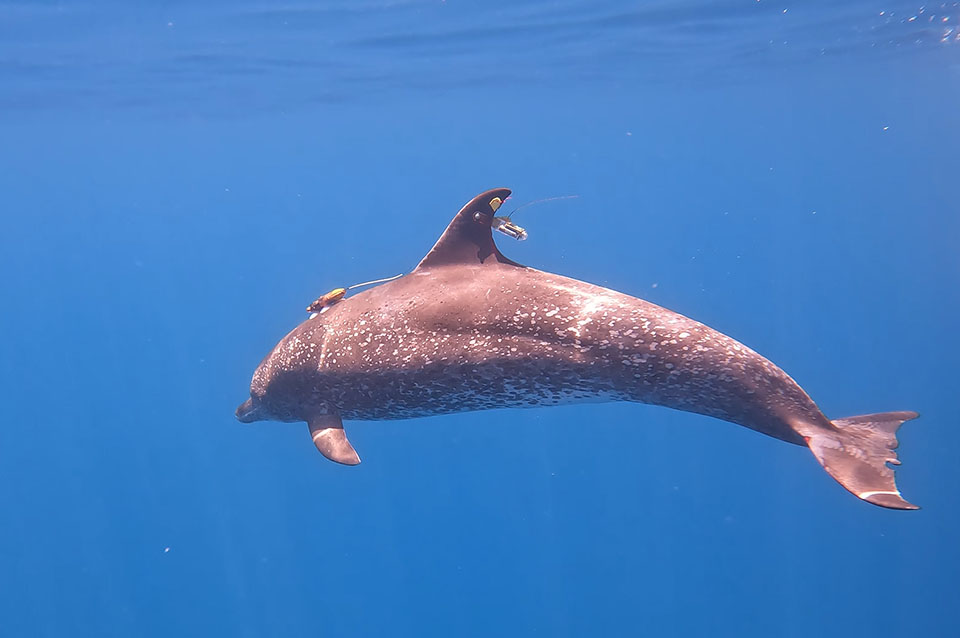Learn About the First Health Assessment of an Offshore Dolphin in the Gulf of Mexico
On June 1, 2022, the SDRP led the first-ever health assessment of an offshore dolphin in the Gulf of Mexico. The collaborative effort involved biologists and veterinarians from six nonprofit organizations and universities and was supported through a Florida RESTORE Act Centers of Excellence grant, through the Florida Institute of Oceanography (FIO).
CZS-SDRP conducts the world’s longest-running study of a wild dolphin population and has been studying bottlenose dolphins in the inshore and coastal Gulf waters since 1970, including periodically performing health assessments on dolphins in shallow inshore waters. The goal of this new project is to study the health and ranging patterns of dolphins in offshore Gulf waters to address important gaps in our knowledge of dolphins there that were identified during investigation of the catastrophic 2010 Deepwater Horizon oil spill.
On June 1, the team — which included the National Marine Mammal Foundation, the University of Florida, Syracuse University, Mote Marine Laboratory, the Chicago Zoological Society, and Fundacion Oceanografic — briefly caught an adult female Atlantic spotted dolphin, gave her a veterinary examination, took biological samples and measurements, then tagged and released her about 27 miles offshore of Sarasota, Florida, over the West Florida Shelf.

This Atlantic spotted dolphin nicknamed “Eugenie Clark” was tagged and released on June 1 by a team of researchers led by the Sarasota Dolphin Research Program in the Gulf of Mexico, offshore of Sarasota, Florida. In this picture, a small satellite-linked tag is temporarily attached to her dorsal fin, and a suction-cup mounted DTAG is located in front of her dorsal fin. The DTAG released automatically 19 hours later as programmed and scientists are now reviewing the data it collected. The satellite-linked tag is programmed to release in a few months.
The dolphin was nicknamed “Eugenie Clark” in honor of the pioneering marine scientist who founded Mote Marine Laboratory in 1955 (where our program began in 1970), and who greatly increased our knowledge of creatures in the Gulf.
Before releasing the dolphin on-site, the research team obtained blood samples for health evaluation, used ultrasound to examine the health of her lungs and other organs, used respirometry to measure lung function, and attached two kinds of temporary electronic tags.
One tag was a satellite-linked transmitter designed to send information on her locations, dive depths, and dive durations every other day over the next several months. This tag is programmed to automatically release in a few months. The second tag was a suction-cup-mounted digital archival tag (DTAG) that recorded sounds and details of her movements until its programmed release the next morning.
Initial data from the satellite-linked transmitter show her moving through the same waters in an area where frequent sightings of spotted dolphins have been reported. Some of her initial dives have been to more than 90-foot depths, near the sea floor, and lasted for more than three minutes. The DTAG was recovered as planned, and recordings indicate that she started feeding about 33 minutes after release and continued feeding near the seafloor thereafter.
The research, led by Sarasota Dolphin Research Program Director Randall Wells, is being conducted through Mote Marine Laboratory, and will continue for three more field sessions over the next two years. The work is focused on both Atlantic spotted dolphins and bottlenose dolphins using shelf waters up to about 50 miles from shore.
The FIO funding through this project also provides continuing support for the Gulf of Mexico Dolphin Identification System (GoMDIS). This collaborative effort involving bottlenose dolphin researchers and stranding programs from around the Gulf facilitates tracking of dolphin movements from matches to contributed dolphin fin images, including identifying movements from one region to another.
This tracking map covering June 1-13 shows the dolphin’s movements following her release.
July 7 Tracking Update
We’ve been tracking the Atlantic spotted dolphin Eugenie Clark since June 1 through a satellite-linked transmitter. She has moved through waters 25-43 miles off the coast between Tampa Bay and Englewood, diving as deep as 45 meters and sometimes staying down for up to four minutes.
These are the first such data available for this species over the West Florida Shelf. The map below shows the locations of her movements recorded by the tag.




